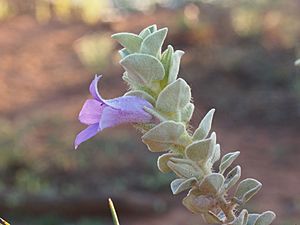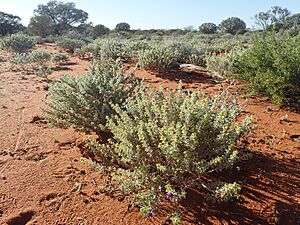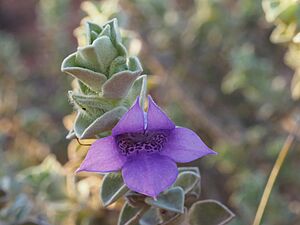Eremophila mackinlayi facts for kids
Quick facts for kids Desert pride |
|
|---|---|
 |
|
| Eremophila mackinlayi subsp. spathulata leaves and flowers | |
| Scientific classification | |
| Genus: |
Eremophila (plant)
|
| Species: |
mackinlayi
|
| Synonyms | |
|
|
Eremophila mackinlayi, also known as desert pride, is a beautiful flowering plant. It belongs to the figwort family, called Scrophulariaceae. This plant grows only in Western Australia, meaning it is endemic there.
Desert pride is a shrub with branches and leaves covered in thick, soft hairs. These hairs can be yellow or grey. Its leaves are usually egg-shaped, and its flowers are a deep lilac or purple color. It is closely related to other plants like E. strongylophylla and E. hygrophana. Sometimes, you can find these plants growing in the same areas.
Contents
What Does Desert Pride Look Like?
Desert pride can be a spreading shrub or grow straight up. It usually reaches a height of about 0.2–1 m (0.7–3 ft) (0.7 to 3.3 feet). Its branches and leaves are covered with many branched hairs, giving them a fuzzy feel.
The leaves have a short stalk, about 2–5 mm (0.08–0.2 in) (0.08 to 0.2 inches) long. The main part of the leaf is usually 10–30 mm (0.4–1 in) (0.4 to 1.2 inches) long and 7–14 mm (0.3–0.6 in) (0.3 to 0.6 inches) wide. They are often egg-shaped or lance-shaped, and sometimes have wavy edges. You can easily see a clear vein on the underside of each leaf.
Flowers and Fruits
The flowers of desert pride grow one by one where the leaves meet the stem. They are on a short, hairy stalk, up to 1.5 mm (0.06 in) (0.06 inches) long. These flowers often grow in tight groups near the ends of the branches.
Each flower has five hairy, narrow sepals (leaf-like parts that protect the bud). These sepals are 8.5–13.5 mm (0.3–0.5 in) (0.3 to 0.5 inches) long. The petals are much longer, about 25–35 mm (0.98–1.4 in) (1 to 1.4 inches) long. They join together at the bottom to form a tube.
The petal tube is deep lilac or purple on the outside. Inside, it is white and has no spots. The outside of the tube and the petal tips are covered with branched hairs. The inside of the petal tips is smooth, but the inside of the tube is very woolly. There are four stamens (parts that produce pollen) hidden inside the petal tube.
Desert pride flowers from May to October. After flowering, it produces oval or bottle-shaped fruits. These fruits are covered with dense, woolly hairs and are about 7.5–10 mm (0.3–0.4 in) (0.3 to 0.4 inches) long.

Plant Name and History
The plant Eremophila mackinlayi was first officially described in 1864. This was done by Ferdinand von Mueller, who was a government botanist in Victoria, Australia. He wrote about it in his book Fragmenta phytographiae Australiae.
The plant's specific name, mackinlayi, was chosen to honor John McKinlay. He was a famous explorer.
Different Types of Desert Pride
There are two types, or subspecies, of Eremophila mackinlayi that scientists recognize:
- E. mackinlayi subsp. mackinlayi: This type has leaves that are oval, egg-shaped, or almost round. These leaves are spread out along the branches.
- E. mackinlayi subsp. spathulata: This type has leaves that are spoon-shaped, or egg-shaped with a narrow base. These leaves tend to grow in clusters at the ends of the branches.
Where Desert Pride Grows
Subspecies mackinlayi Habitat
The mackinlayi subspecies grows in areas close to the coast. You can find it between Shark Bay and Carnarvon in Western Australia. It prefers to grow in sandy soils that contain lime. It is often found in mulga woodlands.
Subspecies spathulata Habitat
The spathulata subspecies grows further inland. It is found between Leonora, Wooleen, and Mullewa. This type usually grows in red-brown loam (a type of soil) near natural water channels. It also grows in mulga woodlands.
Looking After Desert Pride
Both subspecies of desert pride are considered "not threatened" by the Western Australian Government's Department of Parks and Wildlife. This means they are not currently in danger of disappearing.
Growing Desert Pride in Gardens
Many people like to grow desert pride in their gardens. Its soft, felt-like leaves and many blue flowers make it very attractive. The flowers grow in big groups at the ends of the branches.
You can grow this plant from cuttings. However, if you live in southern Australia, it's often better to use grafting. This helps protect the plant from fungal infections that can cause it to die in winter.
Desert pride grows best in soil that drains water well. It likes to be in full sun or partial shade. It also needs good air flow around it. The plant only needs water occasionally during long dry periods. It can handle moderate frost, so it's quite tough!


